RBSE Solutions for Class 12 Maths Chapter 4 Determinants Ex 4.5
Rajasthan Board RBSE Solutions for Class 12 Maths Chapter 4 Determinants Ex 4.5 Textbook Exercise Questions and Answers.
Rajasthan Board RBSE Solutions for Class 12 Maths in Hindi Medium & English Medium are part of RBSE Solutions for Class 12. Students can also read RBSE Class 12 Maths Important Questions for exam preparation. Students can also go through RBSE Class 12 Maths Notes to understand and remember the concepts easily.
RBSE Class 12 Maths Solutions Chapter 4 Determinants Ex 4.5
Question 1.
\(\left[\begin{array}{ll} 1 & 2 \\ 3 & 4 \end{array}\right]\)
Answer:
Let A = \(\left[\begin{array}{ll} 1 & 2 \\ 3 & 4 \end{array}\right]\)
Determinant of matrix A
|A| = \(\left[\begin{array}{ll} 1 & 2 \\ 3 & 4 \end{array}\right]\) = (1 × 4) - (3 × 2) = 4 - 6 = - 2
If Aij is cofactor of aij in A, then
A11 = (- 1)1 + 1 |4| = 4
A12 = (- 1)1 + 2 |3| = - 3
A21 = (- 1)2 + 1 |2| = - 2
A22 = (- 1)2 + 2 |1| = 1
Matrix formed by the cofactors of |A| is
B (say) = \(\left[\begin{array}{cc} 4 & -3 \\ -2 & 1 \end{array}\right]\)
Now, adj A = Transpose of B = \(\left[\begin{array}{cc} 4 & -3 \\ -2 & 1 \end{array}\right]\)

Question 2.
\(\left[\begin{array}{rrr} 1 & -1 & 2 \\ 2 & 3 & 5 \\ -2 & 0 & 1 \end{array}\right]\)
Answer:
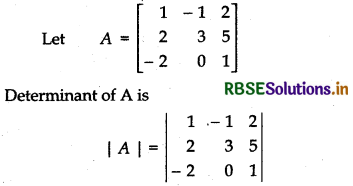
(3 × 1) - (0 × 5) + 1{2 × 1 - (- 2) × 5} + 2{2 × 0 - (- 2) × 3)
= 3 + 0 + 2 + 10 + 2(0 + 6)
= 3 + 2 + 10 + 12 = 27 ≠ 0
If Aij is cofactor of aij in A, then
A11 = (- 1)1 + 1 [(3 × 1) - (0 × 5)] = 3
A12 = (- 1)1 + 2 [(- 1) (2 + 10)0] = - 12
A13 = (- 1)1 + 3[2 × 0 - (- 2) × 3] = 0 + 6 = 6
A21 = (- 1)2 + 1 1 = [(- 1) (- 1)] = 1
A22 = (- 1)2 + 2 = [1 + 4] 5
A23 = (- 1)2 + 3 = [(- 1) (- 2)] = 2
A31 = (- 1)3 + 1 = [- 5 - 6] = - 11
A32 = (- 1)3 + 2 = [(- 1) (5 - 4)] = - 1
A33 = (- 1) 3 + 3 = [1 × 3 - 2(- 1)] = 3 + 2 = 5
Matrix formed by the cofactors of |A| is
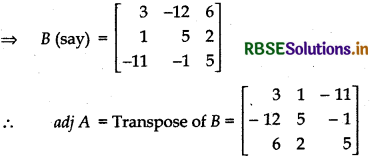
Verify A(adj A) = (adj A) = |A| I in question 3 and 4:

Question 3.
\(\left[\begin{array}{rr} 2 & 3 \\ -4 & -6 \end{array}\right]\)
Answer:
Let A = \(\left[\begin{array}{rr} 2 & 3 \\ -4 & -6 \end{array}\right]\)
Determinant of matrix A is
|A| = \(\left|\begin{array}{rr} 2 & 3 \\ -4 & -6 \end{array}\right|\)
= 2 × (- 6) - (- 4) × 3 = - 12 + 12 = 0
If Aij is cofactor of aij in A then,
A11 = (- 1)1 + 1 (- 6) = - 6
A12 = (- 1)1 + 2 (- 4) = 4
A21 = (- 1)2 + 1 (3) = - 3
A22 = (- 1)2 + 2 (2) = 2
Matrix formed by the cofactors of |A| is
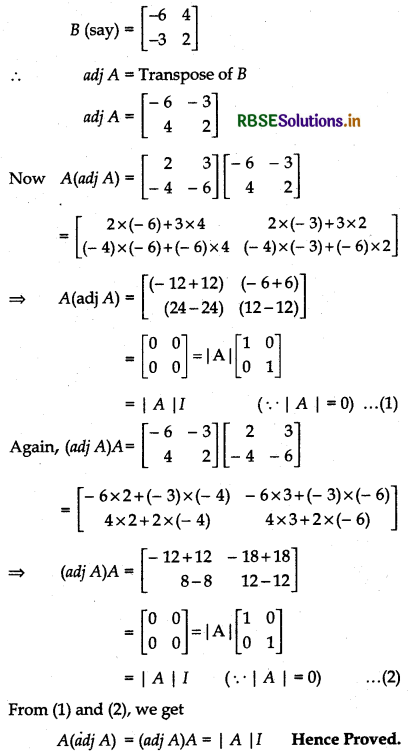

Question 4.
\(\left[\begin{array}{rrr} 1 & -1 & 2 \\ 3 & 0 & -2 \\ 1 & 0 & 3 \end{array}\right]\)
Answer:
Let A = \(\left[\begin{array}{rrr} 1 & -1 & 2 \\ 3 & 0 & -2 \\ 1 & 0 & 3 \end{array}\right]\)
Determinant of A is
|A| = \(\left|\begin{array}{rrr} 1 & -1 & 2 \\ 3 & 0 & -2 \\ 1 & 0 & 3 \end{array}\right|\)
Expanding along C2, we get
|A| = {3 × 3 - 1 × (- 2)} + 0 + 0
∴ |A| = (9 + 2) = 11
A11 = (- 1)1 + 1 [(0 × 3 - 0 × (- 2)] = 3
A12 = (- 1)1 + 2 [(3 × 3 - 1) × (- 2 )] = (- 1) (9 + 2) = - 11
A13 = (- 1)1 + 3[(3 × 0 - 1 × 0)] = 0
A21 = (- 1)2 + 1 1 = [(- 1 × 3 - 0 × 2)] = (- 1) (- 3) = 3
A22 = (- 1)2 + 2 = [1 × 3 - 1 × 2] = 3 - 2 = 1
A23 = (- 1)2 + 3 = [1 × 0 - 1 × (- 1)] = - 1(0 + 1) = - 1
A31 = (- 1)3 + 1 = {- 1 × (- 2) - 0 × 2} = 2
A32 = (- 1)3 + 2 = {1 × (- 2) - 3 × 2} = (- 1) (- 2 - 6) = (- 1) (- 8) = 8
A33 = (- 1) 3 + 3 = [1 × 0 - 3 × (- 1)] = 8
Matrix formed by the cofactors of |A| is:
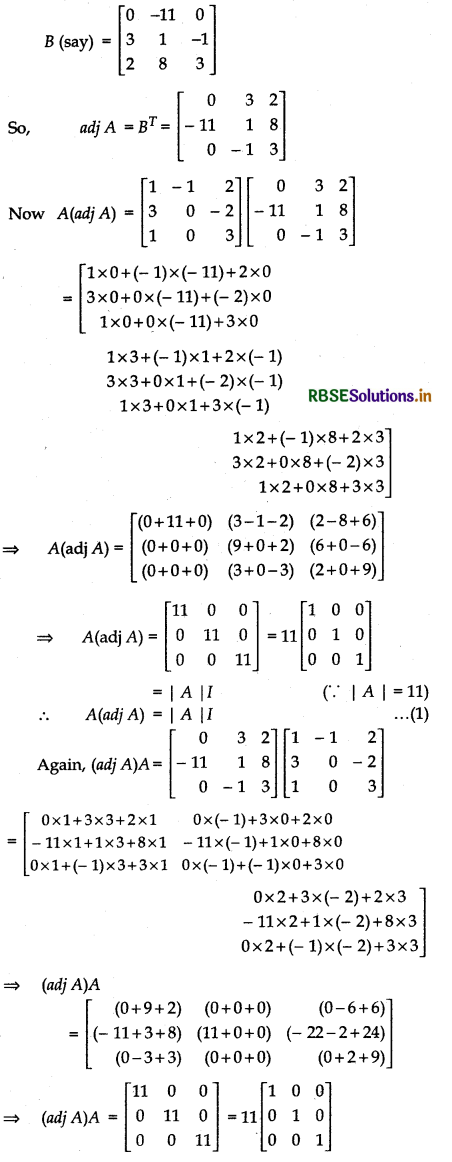
= |A| (∵ |A| = 11)
∴ (adj A)A = |A|I ........ (2)
From (1) and (2), we get
A(adj A) = (adj A)A = |A|I
Hence Proved.

Find the inverse of each of the matrices (if it exists) given in questions 5 to 11:
Question 5.
\(\left[\begin{array}{rr} 2 & -2 \\ 4 & 3 \end{array}\right]\)
Answer:
Let A = \(\left[\begin{array}{rr} 2 & -2 \\ 4 & 3 \end{array}\right]\)
Determinant of A is:
|A| = \(\left|\begin{array}{rr} 2 & -2 \\ 4 & 3 \end{array}\right|\)
= 2 × 3 - 4 × (- 2) = 6 + 8 = 14 ≠ 0
Then, matrix A is non-singular hence A-1 exists.
If Aij is cofactor of aij in A, then
A11 = (- 1)1 + 1 |3| = 3
A12 = (- 1)1 + 2 = - 4
A21 = (- 1)2 + 1 |- 2| = - (- 2) = 2
A22 = (- 1)2 + 2 |2| = 2
Matrix formed by the cofactor of A is
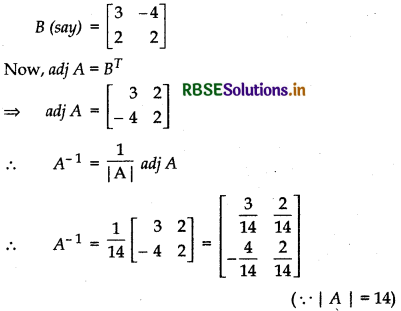
Question 6.
\(\left[\begin{array}{ll} -1 & 5 \\ -3 & 2 \end{array}\right]\)
Answer:
Let A = \(\left[\begin{array}{ll} -1 & 5 \\ -3 & 2 \end{array}\right]\)
Determinant of matrix A is
|A| = \(\left|\begin{array}{ll} -1 & 5 \\ -3 & 2 \end{array}\right|\)
= - 1 × 2 - (- 3) × 5 = - 2 + 15 = 13 ≠ 0
Then matrix A is non-singular hence A-1 exists.
If Aij is cofactor of aij in A, then
A11 = (- 1)1 + 1 (2) = 2
A12 = (- 1)1 + 2 (- 3) = - (- 3) = 3
A21 = ( - 1)2 + 1 (5) = - 5
A22 = (- 1)2 + 2 (- 1) = - 1
Matrix formed by the cofactor of A is
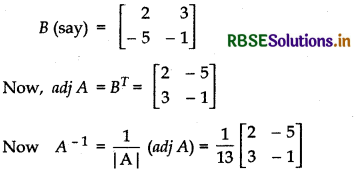

Question 7.
\(\left[\begin{array}{lll} 1 & 2 & 3 \\ 0 & 2 & 4 \\ 0 & 0 & 5 \end{array}\right]\)
Answer:
Let A = \(\left[\begin{array}{lll} 1 & 2 & 3 \\ 0 & 2 & 4 \\ 0 & 0 & 5 \end{array}\right]\)
Determinant of matrix A is
|A| = \(\left[\begin{array}{lll} 1 & 2 & 3 \\ 0 & 2 & 4 \\ 0 & 0 & 5 \end{array}\right]\)
Expanding along C1
= 1(2 × 5 - 0 × 4) = 10 ≠ 0
Thus, matrix A is non-singuiar, i.e., A -1 exists.
If Aij is cofactor of in aij in A, then
A11 = (- 1)1 + 1[2 × 5 - 0 × 4] = 10
A12 = (- 1)1 + 2[(0 × 5 - 0 × 4)] = 0
A13 = (- 1)1 + 3[0 × 0 - 0 × 2)] = 0
A21 = (- 1)2 + 1[(- 1) (2 × 5 - 0 × 3)] = - 10
A22 = (- 1)2 + 2[(1 × 5 - 0 × 3)] = 5
A23 = (- 1)2 + 3[(- 1) (1 × 0 - 0 × 2)] = 0
A31 = (- 1)3 + 1[2 × 4 - 2 × 3 = 8 - 6] = 2
A32 = (- 1)3 + 2[(- 1) (1 × 4 - 0 × 3)] = - 4
A33 = (- 1)3 + 3[(1 × 2 - 0 × 2)] = 2
Matrix formed by the cofactors of |A| is
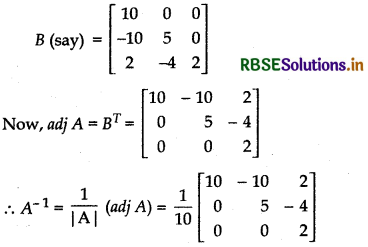
Question 8.
\(\left[\begin{array}{rrr} 1 & 0 & 0 \\ 3 & 3 & 0 \\ 5 & 2 & -1 \end{array}\right]\)
Answer:
Let A = \(\left[\begin{array}{rrr} 1 & 0 & 0 \\ 3 & 3 & 0 \\ 5 & 2 & -1 \end{array}\right]\)
= 1{3 × (- 1) - 2 × 0} - 0 + 0 = - 3 ≠ 0
So, matrix A is non-singular, ie., A-1 exists.
If Aij is cofactor of aij in A, then
A11 = [3 × (- 1) - 2 × 0] = - 3
A12 = - [3 × (- 1) - 5 × 0] = - 1 (- 3) = 3
A13 = + [3 × 2 - 5 × 3] = 6 - 15 = - 9
A21 = - [0 × (- 1) - 2 × 0] = 0
A22 = +[1 × (- 1) - 5 × 0] = - 1
A23 = - [(1 × 2 - 5 × 0)] = - 2
A31 = +[0 × 0 - 3 × 0] = 0
A32 = - [(1 × 0 - 3 × 0)] = 0
A33 = +[1 × 3 - 3 × 0] = 3
Matrix formed by the cofactors of |A| is
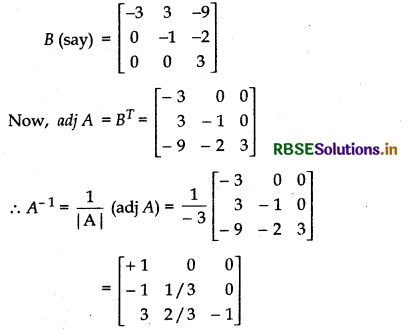

Question 9.
\(\left[\begin{array}{rrr} 2 & 1 & 3 \\ 4 & -1 & 0 \\ -7 & 2 & 1 \end{array}\right]\)
Answer:
Let A = \(\left[\begin{array}{rrr} 2 & 1 & 3 \\ 4 & -1 & 0 \\ -7 & 2 & 1 \end{array}\right]\)
Determinant of matrix A is
|A| = \(\left[\begin{array}{rrr} 2 & 1 & 3 \\ 4 & -1 & 0 \\ -7 & 2 & 1 \end{array}\right]\)
= 2(- 1 × 1 - 2 × 0) - 1(4 × 1 - (- 7) × 0) + 3{4 × 2 - (- 7) × (- 1)}
= - 2 - 4 + 3(8 - 7) = - 2 - 4 + 3 = - 3 ≠ 0
So, matrix A is non-singular, i.e., A-1 exists.
If Aij is cofactor of aij in A, then
A11 = + [- (1 × 1) - (2 × 0)] = - 1
A12 = - [4 × 1 - (- 7) × 0] = - 4
A13 = +[4 × 2 - (- 7) × (- 1)] = 8 - 7 = 1
A21 = - [(1 × 1 - 2 × 3)] = (- 1) (1 - 6) = 5
A22 = +[2 × 1 - (- 7) × 3] = 2 + 21 = 23
A23 = - [2 × 2 - (- 7) × 1] = (- 1) (4 + 7) = - 11
A31 = + [1 × 0 - (- 1) × 3] = 3
A32 = - [(2 × 0 - 4 × 3)] = (- 1) (- 12) = 12
A33 = + [(2 × (- 1) - 4 × 1] = - 2 - 4 = - 6
Matrix formed by the cofactors of |A| is
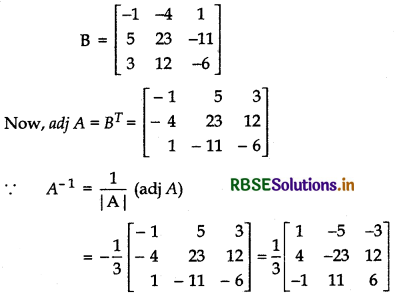
Question 10.
\(\left[\begin{array}{rrr} 1 & -1 & 2 \\ 0 & 2 & -3 \\ 3 & -2 & 4 \end{array}\right]\)
Answer:
Let A = \(\left[\begin{array}{rrr} 1 & -1 & 2 \\ 0 & 2 & -3 \\ 3 & -2 & 4 \end{array}\right]\)
Determinant of matrix A is
|A| = \(\left[\begin{array}{rrr} 1 & -1 & 2 \\ 0 & 2 & -3 \\ 3 & -2 & 4 \end{array}\right]\)
= 1{2 × 4 - (- 2) × (- 3)} + 1{0 × 4 - 3 × (- 3)} + 2{0 × (- 2) - 3 × 2}
= (8 - 6) + (0 + 9) + 2(- 6)
= 2 + 9 - 12 = - 1 ≠ 0
So, matrix A is non-singular, i.e., A-1 exists.
If Aij is cofactor of aij in A, then
A11 = (- 1)1 + 1[2 × 4 - (- 2) × (- 3)] = 8 - 6 = 2
A12 = (- 1)1 + 2 [0 × 4 - 3 × (- 3)] = - 1(+ 9) = - 9
A13 = (- 1)1 + 3 [0 × (- 2) - 3 × 2] = - 6
A21 = (- 1)2 + 1 [- 1 × 4 - (- 2) × 2] = (- 1) (- 4 + 4) = 0
A22 = (- 1)2 + 2 [1 × 4 - 3 × 2] = 4 - 6 = - 2
A23 = (- 1)2 + 3 [1 × (- 2) - 3 × (- 1)] = (- 1) (- 2 + 3) = - 1
A31 = (- 1)3 + 1 [(- 1) × (- 3) - 2 × 2] = 3 - 4 = - 1
A32 = (- 1)3 + 2 [1 × (- 3) - 0 × 2] = (- 1) (- 3) = 3
A33 = (- 1)3 + 3 [1 × 2 - 0 × (- 1)] = 2
Matrix formed by the cofactors of |A| is
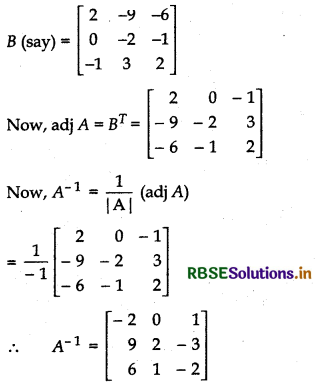

Question 11.
\(\left[\begin{array}{ccc} 1 & 0 & 0 \\ 0 & \cos \alpha & \sin \alpha \\ 0 & \sin \alpha & -\cos \alpha \end{array}\right]\)
Answer:
Let A = \(\left[\begin{array}{ccc} 1 & 0 & 0 \\ 0 & \cos \alpha & \sin \alpha \\ 0 & \sin \alpha & -\cos \alpha \end{array}\right]\)
Determinant of matrix A is
|A| = \(\left|\begin{array}{ccc} 1 & 0 & 0 \\ 0 & \cos \alpha & \sin \alpha \\ 0 & \sin \alpha & -\cos \alpha \end{array}\right|\)
= 1{cos α × (- cos α) - sin α (sin α)} - 0 + 0
= - cos2 α - sin2 a = - (cos2 α + sin2 α)
∴ | A | = - 1 ≠ 0
So, matrix A is non-singular, i.e., A-1 exists.
If Aij is cofactor of aij in A, then
A11 = +[cos α (- cos α - sin α (sin α)] = - cos2 α - sin2 α = - (cos2 α + sin2 α) = - 1
A12 = - {0 × (- cos α) - 0 × (sin α)} = 0
A13 = + [0 × sin α - 0 × cos α] = 0
A21 - [0 × (- cos α) - 0 × sin α] = 0
A22 = + [1 × (- cos α) - 0 × 0] = - cos α
A23 = - [(1 × sin α - 0 × 0)] = - sin α
A31 = + [0 × sin α - cos α × 0] = 0
A32 = - [(1 × sin α - 0 × 0)] = - sin α
A33 = + [1 × cos α - 0 × 0] = cos α
Matrix formed by the cofactors of |A| is
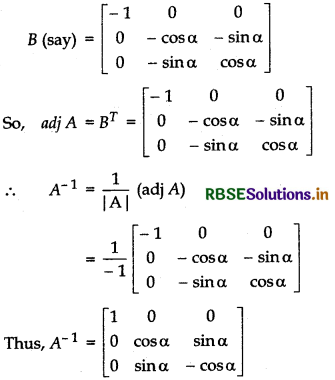
Question 12.
If A = \(\left[\begin{array}{ll} 3 & 7 \\ 2 & 5 \end{array}\right]\) and B = \(\left[\begin{array}{ll} 6 & 8 \\ 7 & 9 \end{array}\right]\), then verify that: (AB)-1 = B-1A-1
Answer:
Let A = \(\left[\begin{array}{ll} 3 & 7 \\ 2 & 5 \end{array}\right]\)
Determinant of matrix A is
|A| = \(\left|\begin{array}{ll} 3 & 7 \\ 2 & 5 \end{array}\right|\)
= 3 × 5 - 2 × 7 = 15 - 14 = 1 ≠ 0
So, matrix A is non-singular, i.e., A-1 exists.
If Aij is cofactor of aij in A, then
A11 = (- 1)1 + 1 (5) = 5
A12 = (- 1)1 + 2 (2) = - 2
A21 = (- 1)2 + 1 (7) = - 7
A22 = (- 1)2 + 2 (3) = 3
Matrix formed by the cofactors of |A| is
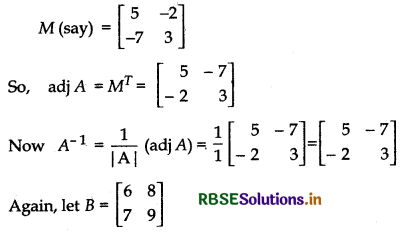
Determinant of matrix B is
|B| = \(\left|\begin{array}{ll} 6 & 8 \\ 7 & 9 \end{array}\right|\) = 6 × 9 - 7 × 8 = - 2 ≠ 0
∴ Matrix B is non-singular so B-1 exists.
If Bij is cofactor of bij in B, then
B11 = (- 1)1 + 1 (9) = 9
B12 = (- 1)1 + 2 (7) = - 7
B21 = (- 1)2 + 1 (8) = - 8
B22 = (- 1)2 + 2 (6) = 6
Matrix formed by the cofactor of |B| is


Question 13.
If A = \(\left[\begin{array}{rr} 3 & 1 \\ -1 & 2 \end{array}\right]\), show that A2 - 5A + 7I = 0. Hence, find A-1.
Answer:
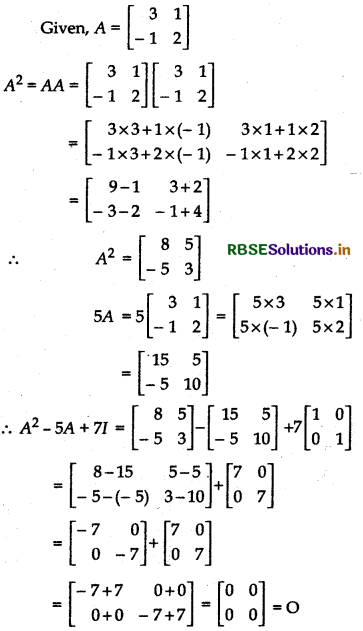
∴ A2 - 5A + 7I = 0
⇒ A2 - 5A = - 7I
⇒ AA - 5A = - &I
Pre-multiplying both sides by A-1
(A-1A)A - 5A-1A = - 7A-1I
⇒ IA - 5I = - 7A-1 (∵ A-1A = I, A-1I = A-1)
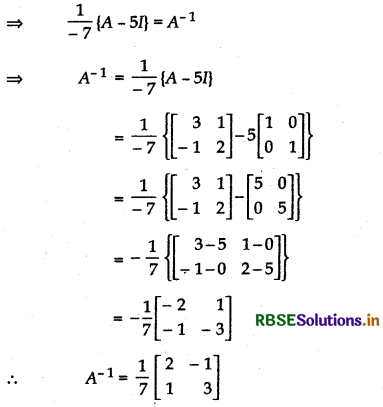
Question 14.
For the matrix A = \(\left[\begin{array}{ll} 3 & 2 \\ 1 & 1 \end{array}\right],\) find the numbers a and b such that A2 + aA + bI = 0.
Answer:
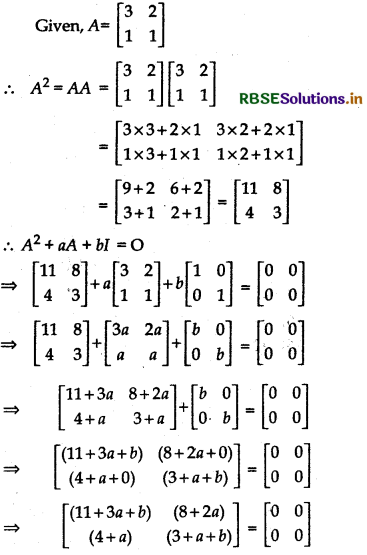
⇒ 11 + 3a + b = 0 ........ (1)
8 + 2a = 0 .......... (2)
4 + a = 0 ............ (3)
3 + a + b = 0 .......... (4)
Now, from equation (3)
4 + a = 0
⇒ a = - 4
Putting a = - 4 in 3 + a + b = 0
3 - 4 + b = 0
⇒ - 1 + b = 0 ⇒ b = 1
Thus a = - 4, b = 1
By a = - 4, b = 1 solving 11 + 3a + b = 0 and 8 + 2a = 0.
11 + 3 × (- 4) + 1 = 11 - 12 + 1 = 0
And 8 + 2 × (- 4) = 8 - 8 = 0
Thus, a and b satisfies 11 + 3a + b = 0 and 8 + 2a = 0.

Question 15.
For the matrix A = \(\left[\begin{array}{rrr} 1 & 1 & 1 \\ 1 & 2 & -3 \\ 2 & -1 & 3 \end{array}\right]\), show that A3 - 6A2 + 5A + 11I = 0. Hence, find A-1.
Answer:

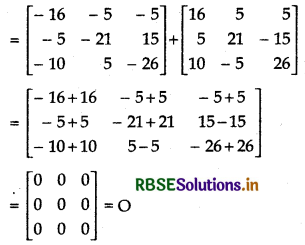
Thus, A3 - 6A2 + 5A + 11I = 0
Multiplying equation A3 - 6A2 + 5A + 11I = 0 by A-1
(A-1A)A2 - 6(AA-1)A + 5(A-1A) + 11(A-1I) = A-1 = 0
⇒ IA2 - 6IA + 5I + 11A-1 = 0
[∵ A-1 A = I, A-1I = A-1, A-10 = 0]
⇒ A2 - 6A + 5I + 11A-1 = 0, (∵ IA = A)
⇒ 11A-1 = - A2 + 6A - 5I
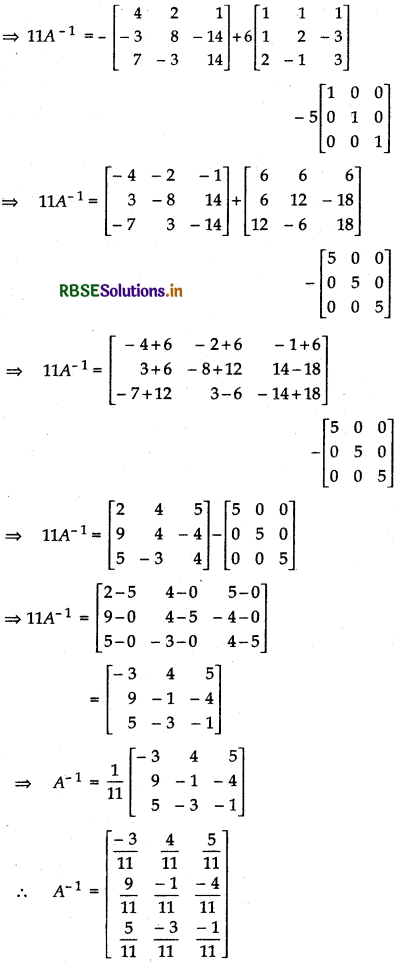

Question 16.
If A = \(\left[\begin{array}{rrr} 2 & -1 & 1 \\ -1 & 2 & -1 \\ 1 & -1 & 2 \end{array}\right]\), verify that A3 - 6A2 + 9A - 4I = 0 and hence find A-1.
Answer:
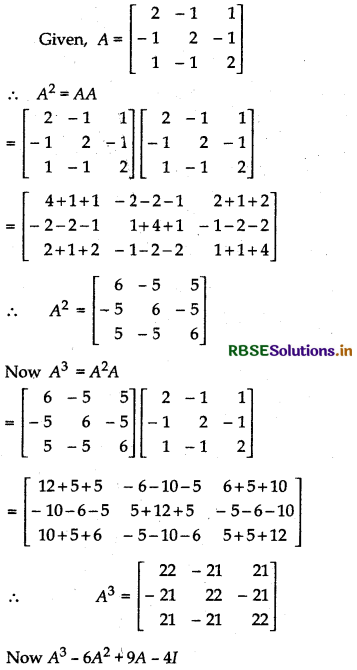
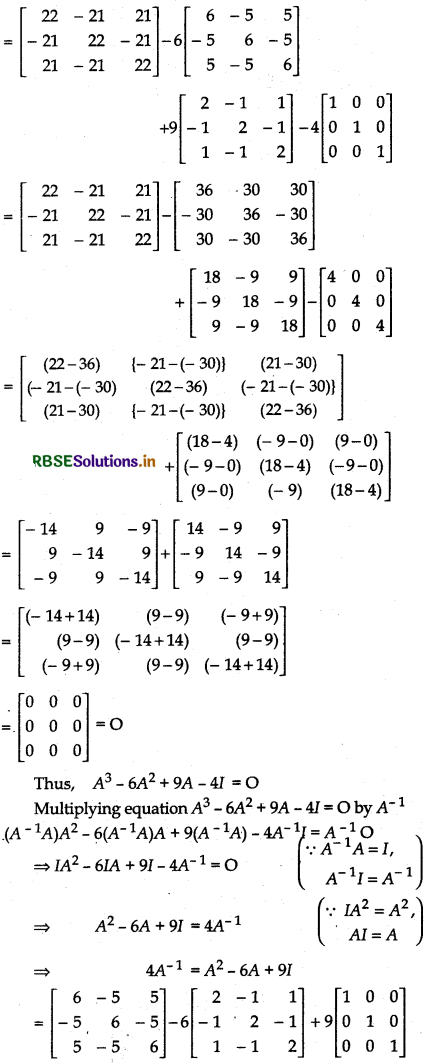
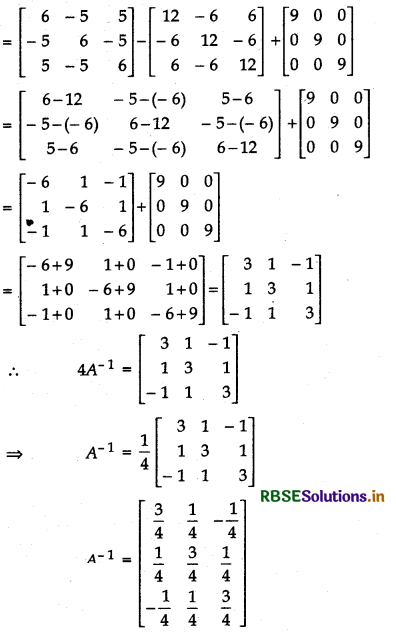

Question 17.
If A be a non-singular square matrix of order 3 × 3, then | adj A | is equal to:
(A) | A |
(B) | A |2
(C) | A |3
(D) 3| A |
Answer:
Given, A be a square matrix of order n × n, then
| adj A |=| A |n - 1
Here n = 3
∴ |adjA | = | A |3 - 1 = | A |2
Thus, option (B) is correct.
Question 18.
If A be an invertible matrix of order 2, then det (A-1) is equal to:
(A) det
(B) \(\frac{1}{{det}(A)}\)
(C) 1
(D) 0
Answer:
Since, A is invertible matrix so its determinant value will not be zero, i.e.,
|A| ≠ 0
∴ AA-1 = 1
⇒ |AA-1| = | I | = 1
⇒ |A| |A-1| = 1 (∵ |AB| = |A| |B|)
⇒ |A-1| = \(\frac{1}{|A|}\)
⇒ det(A-1) = \(\frac{1}{{det}(A)}\)
Thus, option (B) is correct.

- RBSE Class 12 Maths Notes Chapter 13 Probability
- RBSE Class 12 Maths Notes Chapter 12 Linear Programming
- RBSE Class 12 Maths Notes Chapter 11 Three Dimensional Geometry
- RBSE Class 12 Maths Notes Chapter 10 Vector Algebra
- RBSE Class 12 Maths Notes Chapter 9 Differential Equations
- RBSE Class 12 Maths Notes Chapter 8 Application of Integrals
- RBSE Class 12 Maths Notes Chapter 7 Integrals
- RBSE Class 12 Maths Notes Chapter 6 Application of Derivatives
- RBSE Class 12 Maths Notes Chapter 5 Continuity and Differentiability
- RBSE Class 12 Maths Notes Chapter 4 Determinants
- RBSE Class 12 Maths Notes Chapter 3 Matrices